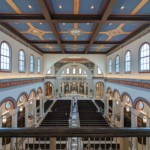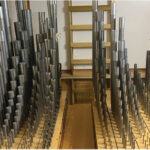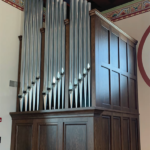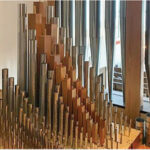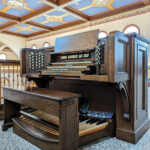Immaculata ChurchSaint Marys, Kansas
3 manuals, 20 ranks
year complete, 2023
In the middle of Kansas, seemingly in the middle of nowhere, sits the newly constructed Immaculata Church in Saint Marys. The magnificent structure stands tall against the Kansas winds, and the brick structure provides a stark contrast to the open, light interior of the building. Walking into the sanctuary, one is imme-diately struck by the craftsmanship of the skilled hands that created the space: marble flooring and altar are surrounded by murals inserted into the ceiling (with a proverbial nod to the Sistine Chapel). Crosses dedicated to the apostles sur-round the nave and bless those who look on. The tall ceilings and ornate artwork provide a worship space unparalleled by modern-day architecture. The blue background gives the feeling that the ceiling opens to Heaven as parishioners sit in pews to pray and sing. In 2021 the church building was not complete, but the congregation needed an instrument to complement the space; something that would expand into it and give additional harmony and accompaniment to voices lifted in praise and sup-plication. This instrument was built and installed in the first half of 2023. The church, in its construction, creates five seconds of reverberation. Because of that, we had to scale the organ to compensate for the magnificent acoustic of the space. Even the mixtures have a say there, because the room carries the upper tones so well. Quimby is also in the process of completing and installing a smaller organ for the transept of the church. With consideration to the demands required of the proposed instrument, we determined that the inspiration for the diapason chorus would be based on the English organbuilder, Thomas C. Lewis (1833–1915), who fashioned his work in the form of the German, Edmund Schulze (1824–1878), who built most of his instruments for English clients. These builders were renowned for their assertive and majestic chorus flue work. In Immaculata, the splendid acoustics and the size of the space called for the use of heroic scales and voicing to achieve our intended goals.
In Immaculata, the splendid acoustics and the size of the space called for the use of heroic scales and voicing to achieve our intended goals.
The major flue chorus complements the chorus reed rank, which incorporates the use of French domed shallots that provide the tonal characteristics of Cavaillé-Coll, and blends to provide full, luscious tones throughout the space. The other ranks in the specification complement the two major flue choruses and The major flue chorus complements the chorus reed rank, which incorporates the use of French domed shallots that provide the tonal characteristics of Cavaillé-Coll, and blends to provide full, luscious tones throughout the space. The other ranks in the specification complement the two major flue choruses and provide a balanced level of dynamics.
The instrument installed in the north transept of Immaculata was built in 1966 by Aeolian-Skinner as their Opus 1483. The organ was secured from the University of Colorado, Boulder, by Quimby Pipe Organs in 2021. A complete rebuild and revoicing, retaining all ranks, was accomplished, incorporating the console from Aeolian-Skinner Opus 1523 from Seventy-Sixth Street Presbyterian Church, Birmingham, Alabama: two manuals and pedal, four ranks, 316 pipes: 16′ Rohrgedeckt (95 pipes); 8′ Spitzflöte (85 pipes); 22⁄3′ Nasat (61 pipes); 4′ Principal (73 pipes);
Those at Quimby Pipe Organs who made contributions to the building and installation of these fine instruments are Michael Quimby, president and tonal director; Eric Johnson, head reed voicer; Joseph Nielson, and Sean Estanek, flue voicers; Brian Seever, service department manager and lead installer; Daniel Sliger, woodshop foreman and lead installer; Charles Ford, project designer; Chris Emerson, executive assistant and lead installer; and the following production and installation team members: Chirt and Aime Touch, Anthony Soun, Mahoney Soun, Bailey Tucker, Bryce Munson, Noah Lipham, Baylee Marten, Rebecca Estanek, and Tygran Gilligan, intern.
View or download PDF
Immaculata Church Saint Marys Kansas

